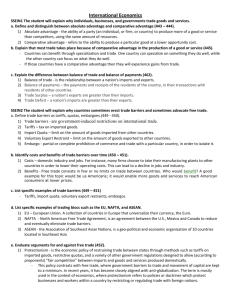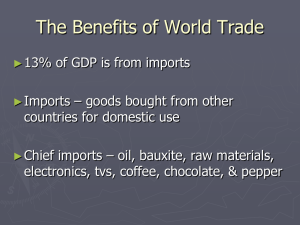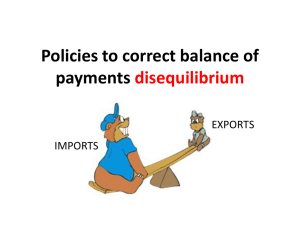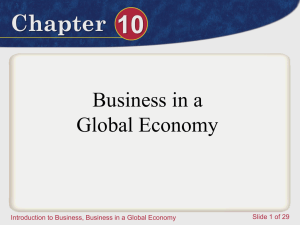GPS Guide International
advertisement
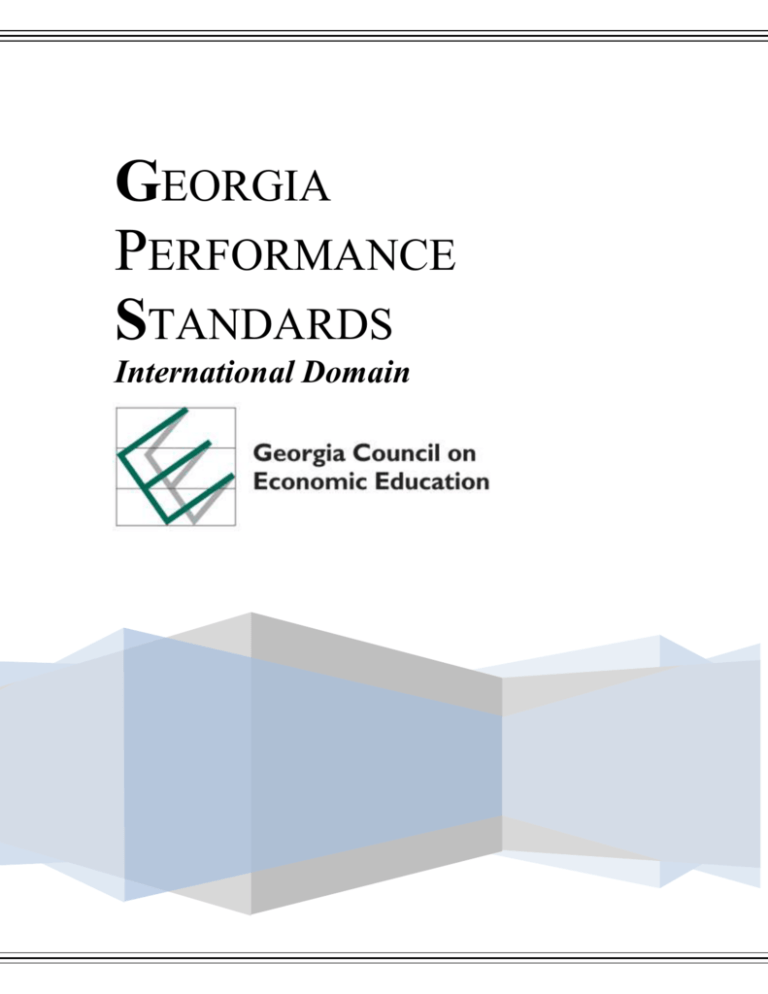
GEORGIA PERFORMANCE STANDARDS International Domain [Type the author name] GEORGIA PERFORMANCE STANDARDS INTERNATIONAL ECONOMICS Fundamental Economic Concepts SSEF3 The student will explain how specialization and voluntary exchange between buyers and sellers increase the satisfaction of both parties. a. give examples of how individuals and businesses specialize Specialization is the basis of trade and interdependence among individuals, cities, regions and countries. Most countries do not produce all of what they consume. Instead, they focus more heavily on producing certain products and trading with other countries. Thus, the global economy is a network of trade and interdependence. Specialization is a situation in which people produce a narrower range of goods and services than they consume. Specialization increases productivity; it also requires trade and increases interdependence. People do not make everything that they and their family use: that is, they do not grow all their own food, sew their own clothes, build their own house and provide themselves personally with health care and education. Instead, people focus on a particular job and then use the wages that they earn from that job to purchase the goods and services they desire. In this way, an economy forms an interlinked network of trade, exchange and interdependence. Because individuals have different skills and interests and because the time and resources necessary to learn new skills are scarce, there is a tendency toward specialization in the production of goods and services. A cobbler specializes in making shoes, while a farmer specializes in growing food. They then exchange (trade) with each other to get the goods they want. By concentrating their talents and efforts in one area, they can produce more shoes and good than if each tried to produce both products. A major consequence of increased productivity due to specialization and exchange is interdependence. The more individuals and national specialize and trade, the more dependent they become on each other to supply their basic wants. Few of us grow all our own food; we rely on farmers. Farmers, in turn, rely on other producers to provide farm machinery. The complex web of interdependence that develops from trade among individuals and nations creates a strong incentive for social cooperation and peaceful coexistence. The more people specialize and trade, the more they must depend on each other. An advantage of specialization and interdependence is that there is a much higher standards of living for both trading partners. Individuals, businesses and governments are motivated by and respond to positive and negative incentives in predictable ways. b. explain that both parties gain as a result of voluntary, non-fraudulent exchange. Trade and voluntary exchange occur when buyers and sellers freely and willingly engage in market transactions. When trade is voluntary and non-fraudulent, both parties benefit and are better off after the trade than they were before the trade. Page 2 of 8 International Economics SSEIN1 The student will explain why individuals, businesses and governments trade goods and services. a. define and distinguish between absolute advantage and comparative advantage Comparative Advantage The ability to produce a good or service at a lower opportunity cost than some other producer. This is the economic basis for specialization and trade. Absolute Advantage The ability to produce more units of a good or service than some other producer, using the same quantity of resources. b. explain that most trade takes place because of comparative advantage in the production of a good or service BENEFITS OF TRADE/COMPARATIVE ADVANTAGE Comparative advantage is the principle which holds that every country should produce and trade the good in which it has a comparative advantage. A nation's comparative advantage occurs when it focuses on producing the good in which the opportunity cost of production is lowest. To understand why this is so, remember that the opportunity cost is the cost of one good in terms of the reduced production of other goods that could have been produced. When a nation focuses on producing the good at which its productivity advantage is greatest, or at which its productivity disadvantage is smallest, it, in effect, chooses to produce the good for which the trade-off with other goods in terms of opportunity cost is smallest. The principle of comparative advantage shows how benefits of trade are available to all parties who participate, both those with a productivity advantage and those with a productivity disadvantage. But it's also important to remember that international trade offers economic benefits for other reasons: it increases competition between firms; it increases the variety available to consumers; it often increases the level of training about matters such as accounting, management and law in low-income countries; and it disseminates new technologies and production methods. To understand the intuition behind comparative advantage, consider a group of volunteers who gather to build a home. One of the volunteers is an expert builder who is better at all tasks than anyone else in the group. However, if that person has to build the house alone, it will take him or her a long time. Comparative advantage says that the skilled builder should focus on the tasks at which that person's advantage is greatest, that is, at which the person's efforts would be hardest to replace. Others should each take on the tasks at which their disadvantage is smallest. In this way, all parties can benefit from the division of labor. Similarly, a high-productivity economy like the United States can benefit from trading with a low-productivity economy like Mexico or certain nations in Africa, because it will be better for all parties if the United States focuses on those products at which its productivity advantage is greatest, and trades with the other countries as they produce those goods in which their productivity disadvantage is least. The gains from trade will be largest when the parties focus on producing in their area of comparative advantage. Page 3 of 8 c. explain the difference between balance of trade and balance of payments BALANCE OF TRADE AND BALANCE OF PAYMENTS Balance of Trade The part of a nation's balance of payments accounts that deals only with its imports and exports of goods (also called merchandise or "visibles"). When "invisibles," or services, are added to the balance of trade, the result is a nation's balance on the current account section of its balance of payments. Balance of Payments The record of all transactions (in goods, services, physical and financial assets) between individuals, firms and governments of one country with those in all other countries in a given year, expressed in monetary terms. The balance of trade is calculated by subtracting imports from exports. The goods and services trade balance counts both exports and imports of goods and services. This measure is increasingly useful because service trade has increased substantially in recent years. When exports exceed imports, a nation is said to have a trade surplus. When imports exceed exports, a nation is said to have a trade deficit. There is no reason at all for exports and imports to be evenly balanced between any two particular countries; instead, it is expected that most countries will have trade deficits with some countries and trade surpluses with other countries. It is unwise to presume that trade surpluses are always desirable and trade deficits are always undesirable. In any given year some nations are likely to have trade surpluses and others to have trade deficits. However, when a nation experiences substantial trade deficits for a sustained period of time, there is reason to be concerned that the country cannot keep consuming high levels of imported products forever. In this situation, adjustment in terms of lower exchange rates should cause imports to fall and exports to rise in the future. When exports occur, the flow of goods headed in one direction out of the country is matched by a flow of payments coming back into the country. Similarly, when imports occur, the flow of goods arriving in the country is matched by a flow of payments leaving the country. The balance of payments refers to the funds received by a country and those paid by a country for all international transactions. The balance of payments includes payments related to exports and imports of goods; payments related to the international flow of services, gifts or transfers; and payments for physical and financial assets such as rental payments or interest payments. It includes all transactions by the individuals, firms and government agencies of one nation and the rest of the world. When the balance of payments includes all inflows and outflows, by definition they must be equal--balance. Page 4 of 8 SSEIN2 The student will explain why countries sometimes erect trade barriers and sometimes advocate free trade a. define trade barriers as tariffs, quotas, embargoes, standards and subsidies Tariff a tax on an imported good or service. Quotas the limit on the quantity of a product that may be imported or exported, established by government laws or regulations; in command economies, more typically a production target assigned by government planning agencies to the producers of a good or service. Embargoes to impose certain conditions before granting consent. It is a Portuguese and Spanish word, meaning an order issued by authority to prevent ships leaving port for a fixed period. Standards expectations for minimal levels of quality to be met; for example, trucks coming from Mexico to meet safety standards, toys important from China to be free of lead paint; cars from Japan meeting EPA guidelines Subsidies financial assistance granted by a government or philanthropic foundation to a person or association for the purpose of promoting an enterprise considered beneficial to the public welfare b. identify costs and benefits of trade barriers over time c. list specific examples of trade bariers Barriers to trade are government rules that block or inhibit international trade between countries. The most common trade restrictions are: 1) tariffs, which are taxes on imports; 2) import quotas, which are limits on the quantity that can be imported; and 3) non-tariff barriers, which include administrative regulations and procedures that can be used to discourage imports. Most barriers to trade are designed to prevent imports from entering a country, and thus are used to protect domestic producers from competition and domestic workers from competition for their jobs. For this reason, a policy of high barriers to trade is referred to as protectionism. However, economists point out that protectionism benefits domestic firms by allowing them to charge higher prices to consumers; in effect, protectionism is an implicit subsidy to the protected firms, paid for by consumers. Although trade barriers may save the jobs of some domestic workers, it destroys jobs in other, probably more efficient, industries. d. list specific examples of trading blocks such as the EU, NAFTA, ASEAN EU – European Union NAFTA – North American Free Trade Agreement [US/Canada/Mexico ASEAN – Association of Southeast Asian Nations MERCOSUR – Common Market of the South [Latin America] Page 5 of 8 Other players on the world stage: BRIC – Brazil, Russia, India, China GATT – General Agreement of Tariffs and Trade WTO – World Trade Organization IMF – International Monetary Fund World Bank e. evaluate arguments for and against free trade. The arguments most often heard AGAINST free trade… It's important to keep jobs in the United States. We don't want money leaving the country. National security is at stake. Other nations don't treat their workers fairly. Other nations are “dumping” and don't open their market to us. The argument FOR free trade…. It is true that some workers in certain industries may be hurt by trade. For example, some U.S. clothing workers have had to change jobs during the past 30 years because many clothes now are imported from other countries. However, this trade allows people in the United States as a whole to buy quality clothing imports at good prices, which results in a higher standard of living for people in the United States and for our trading partners. For this reason, most economists agree that it is good to let countries trade as much as possible. SSEIN3 The student will explain how changes in exchange rates can impact the purchasing power of individuals in the United States and in other countries. When U.S. exporters sell overseas, they want to be paid in dollars. Thus, a demand for dollars is generated when the buyer exchanges his foreign currency for those dollars. Similarly, when a U.S. importer buys from overseas, the foreign seller wants to be paid in his or her national currency. Thus, there is a supply of dollars in the international market as the importer exchanges dollars for the foreign currency in question. The exchange rate is the amount of one country’s currency that is equal to one unit of another country’s currency. Exchange rates are determined primarily by the forces of supply and demand, and foreign exchange markets allocate international currencies. When the exchange rate between two currencies changes, the relative prices of what they are trading also change. In a discussion of the appreciation or depreciation of the dollar, it must always be expressed in terms of an international currency. a. define exchange rate as the price of one nation’s currency in terms of another nation’s currency Exchange Rate The price of one nation's currency in terms of another nation's currency. People exchange currency from their country for another country’s currency for many reasons. One reason is that international trade requires using money from different countries. For example, suppose a California company sells microchips to Japan. The Japanese have “yen” to spend, but the Californians want to end up with U.S. “dollars”. A Japanese company that sells television sets to the United States wants to end up with “yen”, not “dollars”. Somewhere along the way, dollars have to be exchanged for yen. Page 6 of 8 An exchange rate is the price of one nation’s currency in terms of another nation’s currency. Like other prices, exchange rates are determined by the forces of supply and demand. Foreign exchange markets allocate international currencies. When the exchange rate between two currencies changes, the relative prices of the goods and services traded among countries using those currencies change; as a result, some groups gain and others lose. b. locate information on exchange rates – process skill c. interpret exchange rate tables – process skill d. explain why, when exchange rates change, some groups benefit and others lose. If the demand for a nation’s currency rises faster than the supply of its currency in foreign exchange markets, owing to increased demand for that nation’s exports or capital resources, or both, then the value of that nation’s currency will rise (appreciate) relative to other nations’ currencies. That has the effect of making the nation’s exports and capital resources more expensive to people in other countries, and over time these adjustments in exchange rates help to balance a nation’s imports and exports. If the supply rises faster than the demand, the value of a nation’s currency will fall (depreciate) on the foreign exchange market. Page 7 of 8 Page 8 of 8
